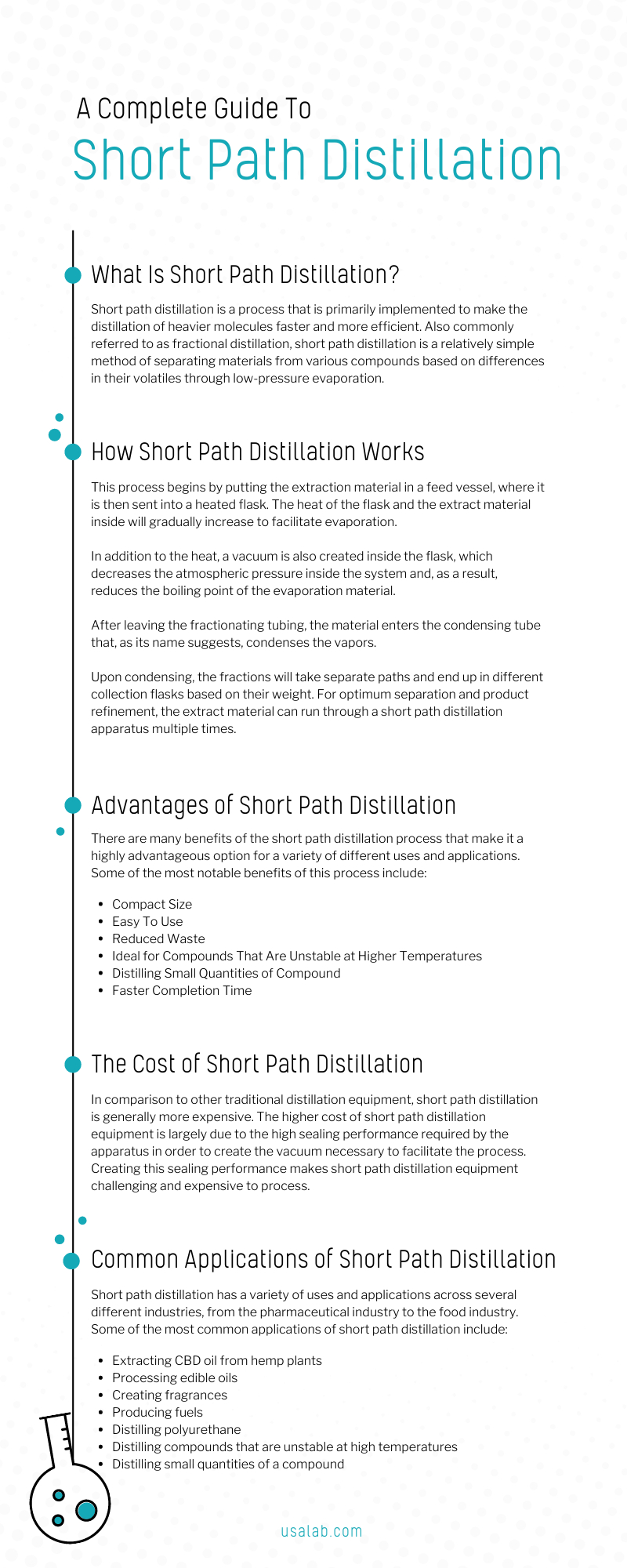Advantages of Short Path Molecular Distillation
Jan 6th 2021
There are many different methods for distilling a substance from a compound. One of the more popular types of distillation is known as short path distillation. Since its development in the 1930s, short path distillation has been used in a wide variety of applications. To learn more about this process, how it works, and what some of its main advantages are, consult this complete guide to short path distillation.
What Is Short Path Molecular Distillation?
Short path distillation is a process that is primarily implemented to make the distillation of heavier molecules faster and more efficient. Also commonly referred to as fractional distillation, short path distillation is a relatively simple method of separating materials from various compounds based on differences in their volatiles through low-pressure evaporation.
The short path molecular distillation process gets its name because the materials being distilled only travel a short distance throughout the apparatus—typically just a few centimeters. Common materials that are extracted through short path distillation include fragrances, fatty acids, fuels, polyurethane, and oils such as CBD oil. Below, we will address how this widely implemented process works.
How Short Path Molecular Distillation Works
Rather than implementing a solvent to help extract the distillate from the material, short path distillation facilitates extraction by taking advantage of the melting points of the material. This process begins by putting the extraction material in a feed vessel, where it is then sent into a heated flask. The heat of the flask and the extract material inside will gradually increase to facilitate evaporation.
In addition to the heat, a vacuum is also created inside the flask, which decreases the atmospheric pressure inside the system and, as a result, reduces the boiling point of the evaporation material. For this reason, short path distillation makes distilling heavier molecules faster and more efficient. In addition, the vacuum also helps speed up the evaporation process by drawing the vapors up into the fractionating tubing. These columns allow the mixed vapors to cool, condense, and re-vaporize. In doing so, they help effectively separate the mixture, as each condensation-vaporization cycle enriches the vapors in a certain component.
After leaving the fractionating tubing, the material enters the condensing tube that, as its name suggests, condenses the vapors. This tube is located close to the heated flask, which means the extract only has to travel a short distance, thus reducing the amount of distillate that is lost throughout the apparatus.
Upon condensing, the fractions will take separate paths and end up in different collection flasks based on their weight. For optimum separation and product refinement, the extract material can run through a short path distillation apparatus multiple times.
Advantages of Short Path Distillation
There are many benefits of the short path distillation process that make it a highly advantageous option for a variety of different uses and applications. Some of the most notable benefits of this process include:
- Compact Size: Short path distillation is a compact purification method. Because it does not take up much space, it is highly advantageous for laboratory applications in which a minimal instrumentation footprint is necessary.
- Easy To Use: Another key benefit of short path distillation is that it is relatively easy to implement. While the majority of conventional distillation methods rely on large, complex apparatuses, short path distillation requires more compact, simple equipment that is still able to achieve high distillate purity levels.
- Reduced Waste: As previously stated, the compound in a short path distillation apparatus only needs to travel a distance of a few centimeters from the heated flask to the condenser tube. As a result, a minimal amount of the compound is lost on the sides of the equipment. Thus, short path distillation can help reduce waste and is highly advantageous for situations in which an expensive compound needs to be distilled.
- Ideal for Compounds That Are Unstable at Higher Temperatures: Because short path distillation uses vacuum pressure to reduce the boiling point of the compounds inside the apparatus, the process can be completed at a lower temperature. For this reason, short path distillation is an ideal option for distilling compounds that are unstable at higher temperatures.
- Distilling Small Quantities of Compound: In addition to distilling compounds that are unstable at higher temperatures, short path distillation is also advantageous for applications that require small quantities of a compound to be distilled. Because the liquid compound travels across a shorter surface area, less compound is lost on the equipment. Thus, smaller quantities can effectively be distilled without losing a large percentage of the product along the way.
- Faster Completion Time: Many conventional evaporation apparatuses can take several hours to complete a separation. Short path distillation, on the other hand, can complete a separation in a matter of seconds due to the pressure vacuum it implements, which helps greatly speed up the process.
The Cost of Short Path Distillation
While short path distillation offers many advantages, there are also a few disadvantages to the process. Perhaps the most noteworthy disadvantage of short path distillation is its cost. In comparison to other traditional distillation equipment, short path distillation is generally more expensive. The higher cost of short path distillation equipment is largely due to the high sealing performance required by the apparatus in order to create the vacuum necessary to facilitate the process. Creating this sealing performance makes short path distillation equipment challenging and expensive to process. That said, the potential for short-path distillation to reduce the amount of wasted compound throughout the process does have the potential to yield significant long-term savings despite a higher initial investment in the equipment.
Common Applications of Short Path Distillation
Short path distillation has a variety of uses and applications across several different industries, from the pharmaceutical industry to the food industry. Some of the most common applications of short path distillation include:
- Extracting CBD oil from hemp plants
- Processing edible oils
- Creating fragrances
- Producing fuels
- Distilling polyurethane
- Distilling compounds that are unstable at high temperatures
- Distilling small quantities of a compound
USA Lab Equipment is a leading provider of high quality new and used laboratory equipment. To acquire an efficient short path distillation kit for your laboratory at a competitive price, shop our extensive online inventory today.


